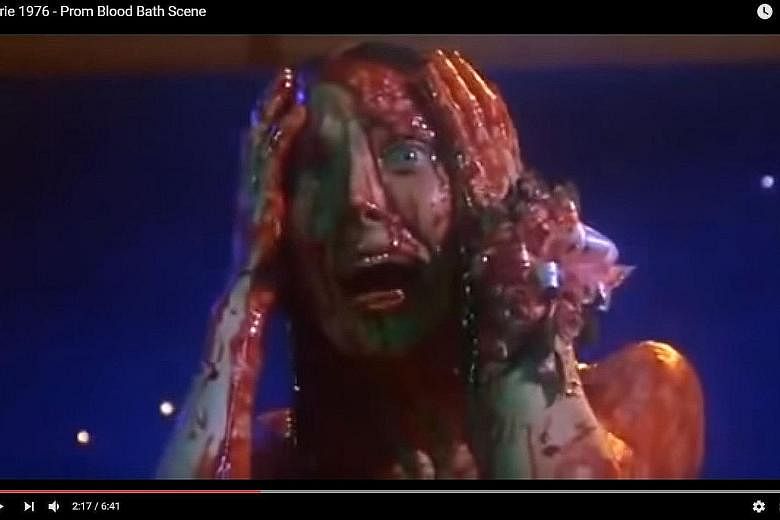NEW YORK • Released a few days after Halloween in 1976, it is considered one of the great American horror films.
A box-office hit with two Oscar nominations for acting, it contains one of the genre's most memorable images and an ending that has been ripped off dozens of times.
It also gave a career lift to a young novelist named Stephen King.
Yet, revisit Carrie 40 years later, as you can do on a new Blu-ray version from Shout! Factory, and you might think: "This... is not that scary."
A high-school drama, yes. A resonant look at the emotional damage caused by bullying, yes. But a horror movie? Not so much.
"I never really approached it as a horror movie," said its director Brian De Palma, who scored his first hit with the film. "It's more of a character piece. She does go berserk after she gets hit with the bucket of blood, but until then, not really.
"What made this really good - both the book and the film - is that it capsulised everyone's high school experience of being an outsider."
King's first published novel Carrie (1974) focuses on the teenage daughter of a repressed religious mother. She is a loner, a victim of constant mockery and able to move things with her mind. She has her first period in the school shower and is assaulted by classmates. After she goes to the senior prom with one of the most popular boys, then is doused with pig's blood as a prank, she goes on a telekinetic rampage.
King has written many doorstoppers, but Carrie is one of his shortest novels. "It's really a simple story," he said. "And people saw Carrie as an extreme case of what they went through in high school."
In the mid-1970s, few had heard of King, a teacher who had mainly published short stories in men's magazines. Lawrence D. Cohen, then working for a movie producer in New York, had certainly never heard of him when he plucked Carrie from a slush pile. He eventually wrote the screenplay.
"I understood why critics were perplexed as to what genre Carrie belonged to," he said. "Was it a high-school movie, a horror piece, a psychological thriller?"
The film eventually landed at United Artists with De Palma as director.
De Palma found a relatively fresh- faced cast, including John Travolta, Betty Buckley, William Katt, Nancy Allen and Amy Irving. Though written in the novel as a "frog among swans", the screen Carrie was Sissy Spacek, who had starred in Terrence Malick's first film, Badlands (1973).
"The studio didn't even want me to test Sissy," De Palma said of Spacek, who had come to audition with Vaseline smeared in her hair to look greasy and unglamorous.
"It's probably the part she'll be best remembered for even though she won an Oscar for another role."
After decades of slasher flicks and torture-porn movies, it is surprising to see how much of Carrie is a naturalistic story about high school: shopping for prom clothes, serving detention, dancing first dances together. That bucket of blood does not fall until the last 20 minutes.
United Artists considered marketing it as a B-movie.
"They wanted to change the title to Pray For Carrie, which is an exploitation-movie title," Cohen said. "And they ended up taking out an ad that was a poster of Carrie covered in blood, which was a spoiler before that word was used, but a clear way of selling the movie."
One reason Carrie is considered such an effective horror movie is its final two minutes, in which Irving's Sue Snell visits a grave and a hand shoots from the ground, sending audiences from the theatre with one more scare.
"What the ending did was establish King as a brand name for horror," said Cohen, who also wrote a Carrie stage musical and the screenplay for the 2013 movie remake.
The success of the original film boosted sales for the novel and King's next novel after the movie, The Shining, became his first hardcover bestseller, and he was off.
NYTIMES

